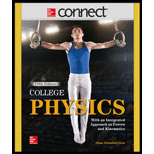
(a)
The volume of air passes through circular area swept out by the blades.
(a)
Answer to Problem 96P
The volume is
Explanation of Solution
Write the expression for volume of air swept out by the blade.
Here
Write the equation for circle as the blade swept out circular area.
Here
Write the expression for the distance travelled by air in the given time.
Here
Substitute (II) and (III) in (I)
Conclusion
Substitute
The volume is
(b)
The mass of air.
(b)
Answer to Problem 96P
The mass of air is
Explanation of Solution
Write the expression for mass in terms of density and volume.
Here
Conclusion
Substitute
The mass of air is
(c)
Translational kinetic energy of the air.
(c)
Answer to Problem 96P
The translational kinetic energy of the air is
Explanation of Solution
Write the expression for translational kinetic energy.
Conclusion
Substitute
The translational kinetic energy of the air is
(d)
The electric power output of the turbine.
(d)
Answer to Problem 96P
The electric power output of the turbine
Explanation of Solution
Write the expression for the power output of the turbine
Here
As the turbine converts
Then (VII) becomes,
Conclusion
Substitute
The electric power output of the turbine
(e)
The power output of the turbine if the speed of the wind is decreased to half its initial value and the conclusion about the electric power production by wind turbines.
(e)
Answer to Problem 96P
The output power of the turbine decreases to
Explanation of Solution
Refer subpart (d) and write the equation for power output of the wind turbine.
Assume that the entire kinetic energy of the wind is converted into electrical energy.
Then,
Substitute (V) in (IX)
Substitute (IV) in (X)
From (XI) it is clear that the power output of the turbine is proportional to the cube of wind speed.
Let
Take the ratio
This indicates that the power production of an individual wind turbine is inconsistent, since modest changes in the wind speed produce large changes in power output.
Conclusion
Therefore, the output power of the turbine decreases to
Want to see more full solutions like this?
Chapter 6 Solutions
COLLEGE PHYSICS-CONNECT ACCESS
 College PhysicsPhysicsISBN:9781305952300Author:Raymond A. Serway, Chris VuillePublisher:Cengage Learning
College PhysicsPhysicsISBN:9781305952300Author:Raymond A. Serway, Chris VuillePublisher:Cengage Learning University Physics (14th Edition)PhysicsISBN:9780133969290Author:Hugh D. Young, Roger A. FreedmanPublisher:PEARSON
University Physics (14th Edition)PhysicsISBN:9780133969290Author:Hugh D. Young, Roger A. FreedmanPublisher:PEARSON Introduction To Quantum MechanicsPhysicsISBN:9781107189638Author:Griffiths, David J., Schroeter, Darrell F.Publisher:Cambridge University Press
Introduction To Quantum MechanicsPhysicsISBN:9781107189638Author:Griffiths, David J., Schroeter, Darrell F.Publisher:Cambridge University Press Physics for Scientists and EngineersPhysicsISBN:9781337553278Author:Raymond A. Serway, John W. JewettPublisher:Cengage Learning
Physics for Scientists and EngineersPhysicsISBN:9781337553278Author:Raymond A. Serway, John W. JewettPublisher:Cengage Learning Lecture- Tutorials for Introductory AstronomyPhysicsISBN:9780321820464Author:Edward E. Prather, Tim P. Slater, Jeff P. Adams, Gina BrissendenPublisher:Addison-Wesley
Lecture- Tutorials for Introductory AstronomyPhysicsISBN:9780321820464Author:Edward E. Prather, Tim P. Slater, Jeff P. Adams, Gina BrissendenPublisher:Addison-Wesley College Physics: A Strategic Approach (4th Editio...PhysicsISBN:9780134609034Author:Randall D. Knight (Professor Emeritus), Brian Jones, Stuart FieldPublisher:PEARSON
College Physics: A Strategic Approach (4th Editio...PhysicsISBN:9780134609034Author:Randall D. Knight (Professor Emeritus), Brian Jones, Stuart FieldPublisher:PEARSON





